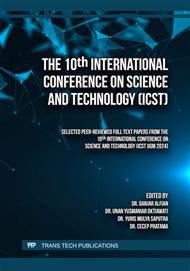[1]
W. C. Wei, T. Mizumoto, and K. Yasumoto, "Physical burden prediction for cycling on arbitrary route," Oct. 2018. Accessed: Nov. 21, 2021. [Online]. Available:
DOI: 10.1109/gcce.2018.8574483
Google Scholar
[2]
H. Huang and E. N. Ceesay, "Statistical and Transfer Learning Model to Analyze Endurance Performance with Aging," 2021 IEEE International IOT, Electronics and Mechatronics Conference (IEMTRONICS), 2021, pp.1-6
DOI: 10.1109/IEMTRONICS52119.2021.9422586
Google Scholar
[3]
M. Altini and O. Amft, "Estimating Running Performance Combining Non-invasive Physiological Measurements and Training Patterns in Free-Living," 2018 40th Annual International Conference of the IEEE Engineering in Medicine and Biology Society (EMBC), 2018, pp.2845-2848.
DOI: 10.1109/EMBC.2018.8512924
Google Scholar
[4]
N. Khasawneh, C. Schulte and M. Fraiwan, "A Framework for Crowd-Sourced Exercise Data Collection and Processing," 2020 11th International Conference on |Information and Communication Systems (ICICS), 2020, pp.313-317.
DOI: 10.1109/ICICS49469.2020.239546
Google Scholar
[5]
Y. Qiu, X. Zhu and J. Lu, "Fitness Monitoring System Based on Internet of Things and Big Data Analysis," in IEEE Access, vol. 9, pp.8054-8068, 2021.
DOI: 10.1109/ACCESS.2021.3049522
Google Scholar
[6]
G. Xu et al., "An IoT-Based Framework of Webvr Visualization for Medical Big Data in Connected Health," in IEEE Access, vol. 7, pp.173866-173874, 2019, doi: 10.1109/ACCESS. 2019.2957149
DOI: 10.1109/access.2019.2957149
Google Scholar
[7]
Stauffer, J., Zhang, Q. s2Cloud: a novel cloud-based precision health system for smart and secure IoT big data harnessing. Discov Internet Things 4, 3 (2024).
DOI: 10.1007/s43926-024-00055-8
Google Scholar
[8]
"Strava Developers." https://developers.strava.com/ (accessed Nov. 24, 2021).
Google Scholar
[9]
H. Dagdougui, F. Bagheri, H. Le, and L. Dessaint, "Neural network model for short-term and very-short-term load forecasting in district buildings," Energy and Buildings, vol. 203, p.109408, Nov. 2019.
DOI: 10.1016/j.enbuild.2019.109408
Google Scholar
[10]
J. Mohammadi, M. Ataei, R. Khalo Kakaei, R. Mikaeil, and S. Shaffiee Haghshenas, "Prediction of the Production Rate of Chain Saw Machine using the Multilayer Perceptron (MLP) Neural Network," Civil Engineering Journal, vol. 4, no. 7, p.1575, Jul. 2018.
DOI: 10.28991/cej-0309196
Google Scholar
[11]
B. T. Pham, M. D. Nguyen, K.-T. T. Bui, I. Prakash, K. Chapi, and D. T. Bui, "A novel artificial intelligence approach based on Multi-layer Perceptron Neural Network and Biogeography-based Optimization for predicting coefficient of consolidation of soil," CATENA, vol. 173, p.302–311, Feb. 2019.
DOI: 10.1016/j.catena.2018.10.004
Google Scholar
[12]
F. R. Lima-Junior and L. C. R. Carpinetti, "Predicting supply chain performance based on SCOR® metrics and multilayer perceptron neural networks," International Journal of Production Economics, vol. 212, p.19–38, Jun. 2019
DOI: 10.1016/j.ijpe.2019.02.001
Google Scholar
[13]
"Python Machine Learning Multiple Regression." https://www.w3schools.com/python/python_ml_multiple_regression.asp (accessed Dec. 05, 2021).
Google Scholar
[14]
O. El Aissaoui, Y. El Alami El Madani, L. Oughdir, A. Dakkak, and Y. El Allioui, "A Multiple Linear Regression-Based Approach to Predict Student Performance," in Advances in Intelligent Systems and Computing, Cham: Springer International Publishing, 2020, p.9–23. Accessed: Dec. 05, 2021. [Online]. Available:
DOI: 10.1007/978-3-030-36653-7_2
Google Scholar
[15]
S. Rath, A. Tripathy, and A. R. Tripathy, "Prediction of new active cases of coronavirus disease (COVID-19) pandemic using multiple linear regression model," Diabetes & Metabolic Syndrome: Clinical Research & Reviews, vol. 14, no. 5, p.1467–1474, Sep. 2020.
DOI: 10.1016/j.dsx.2020.07.045
Google Scholar
[16]
Awad M., Khanna R. (2015) Support Vector Regression. In: Efficient Learning Machines. Apress, Berkeley, CA
DOI: 10.1007/978-1-4302-5990-9_4
Google Scholar
[17]
B. Panwar, G. Dhuriya, P. Johri, S. Singh Yadav and N. Gaur, "Stock Market Prediction Using Linear Regression and SVM," 2021 International Conference on Advance Computing and Innovative Technologies in Engineering (ICACITE), 2021, pp.629-631, doi:10.1109/ ICACITE51222.2021.9404733.
DOI: 10.1109/icacite51222.2021.9404733
Google Scholar


